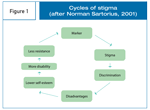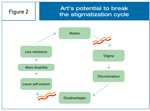Psychiatry and Art
Freud famously quipped: "The creative writer cannot evade the psychiatrist nor the psychiatrist the creative writer."

Art has the capacity to change the self-orientation of both the artist and the viewer. In producing art, the artist interacts with his or her internalized objects. The creative act can thus become a therapeutic tool, extending from verbal experiences into nonverbal and pre-verbal experiences across all stages of psychological development. Significantly, art allows for critical distance, retrospection, and vast opportunities for individual choice and, thus, may be conducive to an improved self-image and self-esteem. Dr Janos Marton,1 the Director of the Living Museum, believes that the success of his innovative psychiatric rehabilitation program stems from capitalizing on the intrinsic properties of the artistic process: “The patient’s particularized, broken, fragmented self must fit into a more manageable flow. Then, the patient eases his/her way into a slow process of identity change. . . . Self-transformation is the objective of all art, and the [patient] artists . . . no less than others.”
Dynamics of art
Art perception relies on a dialogical communication between the artist, the audience, and the cultural tradition that allows for new interpretations to be made and new meanings to be generated. Inherent in all artistic activity, these dialogical mechanisms become particularly striking in outsider art and can serve as a basis for fighting stigma. All artistic creation is a bridge to the social: art can exist only among other art and must be preceded by art. “An isolated text is incapable of generating meanings; like any dynamic generating system, a text requires input of outside information, which in this case implies an interaction with other texts and cultural environments.”2 The aesthetic value of an artwork does not depend on the fulfilment of the norm. In non-artistic communication, it is not the language but its content that carries information: we do not pay attention to the shade of red used on a stop sign. While this aspect of communication remains present in art, it is not exclusive nor is it necessarily the primary one.
Although in a non-artistic communication it is precisely the adherence to the rules that ensures adequate transmittal of a message, in a work of art this proves insufficient and is often detrimental. Simple adherence to a set of rules does not create aesthetic value. “If we dealt only with a strict system of rules, each new work would represent an exact copy of a previous one, redundancy would prevail over entropy and the artwork would lose its informational value.”3 Kitsch is an example of artwork that follows well-known models closely, without contributing any original interpretation.
If mere adherence to the norm does not create artistic value, neither does the complete destruction of the norm. The long-standing popular misconception of outsider art as free from existing conventions, social or aesthetic, has been easily challenged in an age when access to the internet is widespread and long-term institutional isolation of patients is rare; more important, this contradicts the nature of the artwork as a semiotic structure. Indeed, art without any rules, without structural relationships is impossible. Limitless choices, absence of rules, and absolute freedom from any set limits are not the ideal but rather the death of communication.
When faced with an unknown alphabet whose rules are effectively nonexistent for us, we are unable to decipher any message at all. At the most abstract level, art represents a dynamic relationship between following an existing aesthetic norm and deviating from it. A closer analysis shows that a work of art often exists at the intersection of multiple concurrently active aesthetic norms. Any living culture depends on constant exchange between the peripheral and mainstream, archaic and innovative, high-brow and low-brow; it is this dynamic that allows art to accumulate new meaning over time.
Art production allows a maximum freedom of choice for the artist while at the same time providing a connection to existing rules, conventions, and structures. The greater the number of potential choices available to the artist, the more valuable is the information represented by a particular choice. The audience’s assumptions of the artist’s intention and accountability play a particularly big role in the interpretation of outsider art. The more the audience is aware of an existing artistic model on whose background the given artwork functions, the stronger they perceive that work’s uniqueness. The individual and the universal are no longer isolated but, on the contrary, require each other.
What new information does this article provide?
? The article focuses on the theoretical framework underpinning the contemporary understanding of the dynamics of psychiatric art. Using the semiotic approach to art production and perception, the article makes the connection between the dialogical mechanisms of art and the potential uses of art to counteract stigma, including self-stigmatization.
What are the implications for psychiatric practice?
? Creative works by patients provide a key source of information in the diagnostic process. Furthermore, because all artistic activity is a communicative act, working with patient art aids in gaining a better understanding of the preserved aspects of a patient’s personality, beyond the pathological syndromes, and in building a better rapport. Gaining insight into patient art allows for more effective planning of the specific medical and social rehabilitation strategies. At the community level, outsider art is a powerful tool in anti-stigma campaigns.
Aesthetic function arises at the intersection of a highly individual activity and the established cultural codes and structures. Any art object is saturated with values and must be analyzed in relation to its surrounding society in order to understand how it is perceived. Connecting spectators to meaning just as it connects the artists to collectors, art fosters cooperative communication in which the dignity and individuality of a mental health patient may be reaffirmed.
Tracy Reinhardt, a self-taught artist, has talked frankly in an interview about how the gradual development of her identity as an artist had first served as a way of coming to terms with her disorder:
I started drawing constantly several months prior to being diagnosed. The drawings weren’t art-they were about getting as many thoughts on the outside as I could. As I put each thought on paper I gave it a place to live. I did one drawing after another, and when each was done there was a sense of relief. Seeing the drawings was like seeing evidence of a burden I no longer had to carry. At the time, I wouldn’t have called what I was doing creative in an artistic sense but I do think it was a creative coping strategy.4
Initially, the process of artistic creation helped her communicate with the cultural context and, through it, establish an inner dialogue. Over time, as she discovered her creative abilities, explored her style, and developed new techniques, her artwork moved beyond a solely therapeutic function: the dialogue expanded to include outside viewers.
I’ve changed a lot in the last ten years, and so has my artistic style. What I want to do now, why I want to do it. . . . What I need out of it-it’s all different. I don’t need so much emotionally from the artwork. I want to do it very much, I enjoy it. . . . It calms me, satisfies me. . . . Makes me happy. . . . But the doing isn’t about spilling. It’s a more peaceful giving process. And the art is more peaceful and reflective.4
In the same interview, Ms Reinhardt talks poignantly of the value of audience input:
I’ve received many comments from people who saw my work on the internet-not necessarily people who bought it, simply those looking-saying that it expresses just what they feel, and that it was a relief to see their own feelings articulated. Writing is a very good way to deal with stigma but so is art. Art of all kinds. I think creativity is something that is deeply ingrained in people . . . albeit something that gets squashed quickly.
Counteracting stigma
The artworks attracted the attention of outside viewers, who often found them relevant to their own experience by expressing an insight into the human condition that is no longer reducible to the personal history of an individual artist. The marker was effaced. In this way, the creative process bolstered the artist’s self-esteem and resilience, helping counteract both social stigma and self-stigmatization. Public exhibitions of psychiatric art may also be an effective tool in anti-stigma campaigns, as promoted by the World Psychiatric Association and its Section on Art and Psychiatry.5 Such exhibitions counteract negative social stereotypes of mental illness and undermine the cultural mechanisms for stigma.
Figure 1

Cycles of stigma (after Norman Sartorius, 2001)
Any culturally active artwork has the potential to change the structural self-orientation of the viewer’s or reader’s personality, to transform both that personality and the degree to which it is connected to metacultural constructions. In the words of Joseph Brodsky,6 a Nobel Prize Laureate for Literature, “the more substantial an individual’s aesthetic experience is . . . the freer . . . he is.” This is even more true in the case of patients who struggle with mental illness, who often find themselves constrained by both the reality of their medical condition and the social stigma that surrounds it. To help visualize the potential of art for combating stigma and promoting inclusion, we can turn to the conceptual model of “vicious circles” of stigmatization as formulated by Sartorius (Figure 1).7,8
According to this formulation, a marker that allows a person to be identified with it can be loaded with negative content by association with existing stereotypes and prejudices. Once a marker is negatively loaded, it becomes stigma, and the individual who bears it will inevitably be stigmatized. The experience of discrimination leads to impaired functioning and reinforces stigma, establishing a vicious circle.
Figure 2

Art's potential to break the stigmatization cycle
Art can counteract stigma by weakening or breaking this vicious circle in 2 ways (Figure 2). The dialogical mechanisms of art may be built on to prevent a marker from becoming associated with stigma. Stigmatization has at its root the objectification of the other, that is, denying the right to be an independent agent in the communication process. It also involves rejection of any new information that may lead to the alteration of existing constructs. In sum, stigmatization is a breakdown of communication. Art affords a viable alternative: a model of dialogue in which the other is accepted as an equal partner in the communication process. This explains the potential of art to promote the acceptance of a person in his or her full subjective being, “In his or her totality,” to use an expression of Jean Delay.
Conclusion
The visual arts and literature have long been recognized as valuable sources for describing psychological states. Freud9 famously quipped: “The creative writer cannot evade the psychiatrist nor the psychiatrist the creative writer.” Art needs to be acknowledged as a social force that can shape dominant cultural values that underpin the functional concepts of health and disease.
Many higher-education institutions are considering ways to incorporate humanities into their medical curricula, recognizing the role played by social constructs in health care policies. A number of hospitals in the US and Canada offer workshops to their staff aimed at enhancing cultural competence and communication skills as well as decreasing staff burnout. The role assigned to art in modern psychiatry has been evolving. It was first seen almost exclusively as a diagnostic tool; later, art started being used for its therapeutic properties. Art is now gradually being tapped for its social function in anti-stigma interventions. Seizing the dialogical potential of art, we can change the context in which mental illness is experienced and work toward a greater acceptance and integration.
References:
References
1. Marton J. Journey of Hope: Artwork From the Living Museum, a Space for Art and Healing. New York: Bristol-Myers Squibb Co/Todd Street Productions; 2002.
2. Lotman YU.M. Izbrannye Stat’i [Selected Articles]. Vol 1. Tallinn, Estonia: Alexandra; 1992:146-147.
3. Lotman YU.M. Ob Iskusstve [On Art]. St Petersburg, Russia: Isskustvo-SPb; 1998:276.
4. Sukhanova E. Tracy Reinhardt Interview. In: Thomashoff H-O, Sukhanova E, eds. The Person in Art: Conceptual and Pictorial Frames on Art and Mental Health. New York: Nova Publishers; 2008:129-132.
5. Thomashoff H-O, ed. Human Art Project: Art for Anti-Stigma. Stuttgart, Germany: Schattauer; 2002.
6. Brodsky J. Uncommon visage. In: On Grief and Reason. New York: Farrar, Straus and Giroux; 1995:49-50.
7. Sartorius N. Breaking the vicious circle. Ment Health Learn Disabil Care. 2000;4:80.
8. Smith M. Stigma. Adv in Psychiatr Treat. 2002;8:317-325.
9. Freud S. Complete Psychological Works of Sigmund Freud. Vol 9. London; Hogarth Press: 1959:43.
